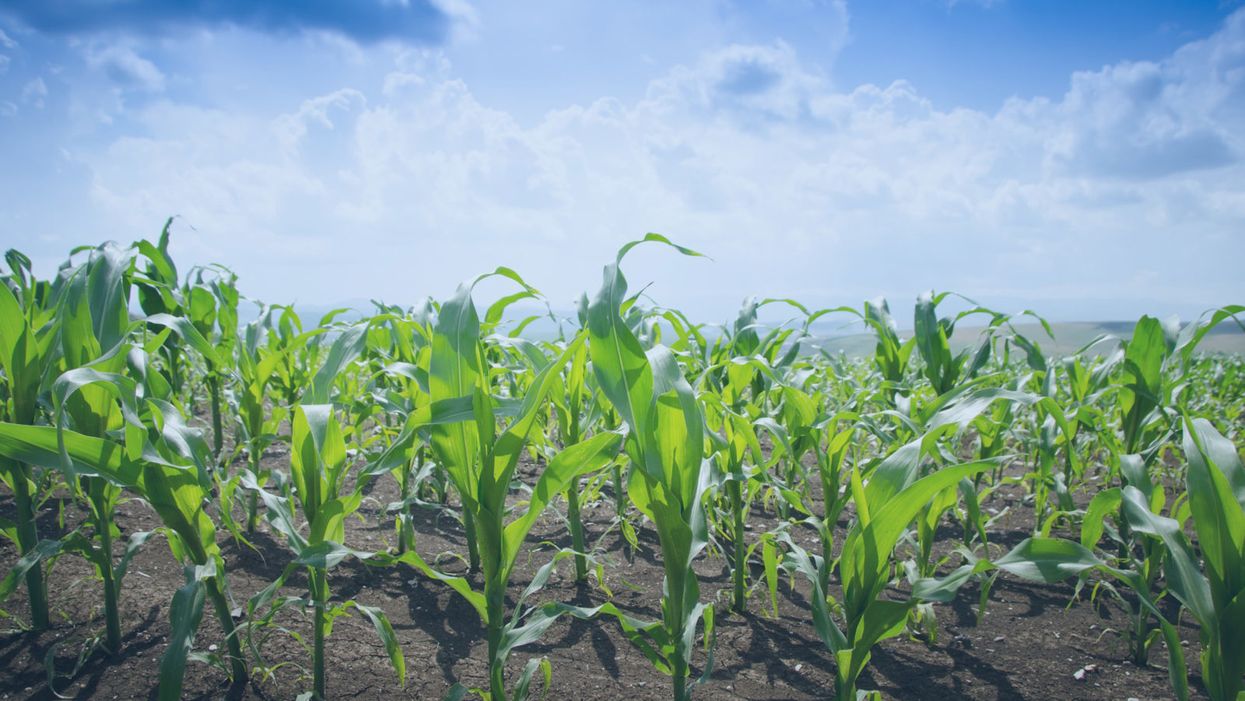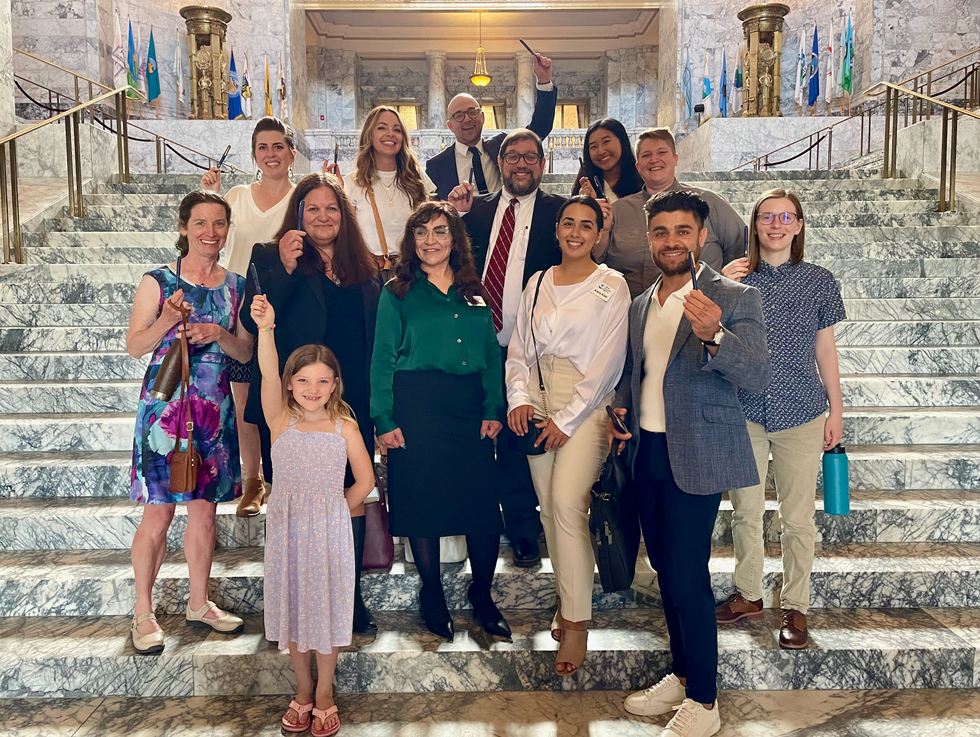Technology’s Role in Feeding a Soaring Population Raises This Dilemma

When farmer Terry Wanzek walks out in his fields, he sometimes sees a grove of trees, which reminds him of his grandfather, who planted those trees. Or he looks out over the pond, which deer, ducks and pheasant use for water, and he knows that his grandfather made a decision to drain land and put the pond in that exact spot.
Growing more with fewer resources is becoming increasingly urgent as the Earth's population is expected to hit 9.1 billion by 2050.
"There is a connection that goes beyond running a business and making a profit," says Wanzek, a fourth-generation North Dakota farmer who raises spring wheat, corn, soybeans, barley, dry edible beans and sunflowers. "There is a connection to family, to your ancestors and there is a connection to your posterity and your kids."
Wanzek's corn and soybeans are genetically modified (GM) crops, which means that they have been altered at the DNA level to create desirable traits. This intervention, he says, allows him to start growing earlier and to produce more food per acre.
Growing more with fewer resources is becoming increasingly urgent as the Earth's population is expected to hit 9.1 billion by 2050, with nearly all of the rise coming from developing countries, according to the Food and Agriculture Organization of the United Nations. This population will be urban, which means they'll likely be eating fewer grains and other staple crops, and more vegetables, fruits, meat, dairy, and fish.
Whether those foods will be touched in some way by technology remains a high-stakes question. As for GM foods, the American public is somewhat skeptical: in a recent survey, about one-third of Americans report that they are actively avoiding GMOs or seek out non-GMO labels when shopping and purchasing foods. These consumers fear unsafe food and don't want biotechnologists to tamper with nature. This disconnect—between those who consume food and those who produce it—is only set to intensify as major agricultural companies work to develop further high-tech farming solutions to meet the needs of the growing population.
"I don't think we have a choice going forward. The world isn't getting smaller. We have to come up with a means of using less."
In the future, it may be possible to feed the world. But what if the world doesn't want the food?
A Short History
Genetically modified food is not new. The first such plant (the Flavr Savr tomato) was approved for human consumption and brought to market in 1994, but people didn't like the taste. Today, nine genetically modified food crops are commercially available in the United States (corn, soybean, squash, papaya, alfalfa, sugar beets, canola, potato and apples). Most were modified to increase resistance to disease or pests, or tolerance to a specific herbicide. Such crops have in fact been found to increase yields, with a recent study showing grain yield was up to 24.5 percent higher in genetically engineered corn.
Despite some consumer skepticism, many farmers don't have a problem with GM crops, says Jennie Schmidt, a farmer and registered dietician in Maryland. She says with a laugh that her farm is a "grocery store farm - we grow the ingredients you buy in products at the grocery store." Schmidt's father-in-law, who started the farm, watched the adoption of hybrid corn improve seeds in the 1930s and 1940s.
"It wasn't a difficult leap to see how well these hybrid corn seeds have done over the decades," she says. "So when the GMOs came out, it was a quicker adoption curve, because as farmers they had already been exposed to the first generation and this was just the next step."
Schmidt, for one, is excited about the gene-editing tool CRISPR and other ways biotechnologists can create food like apples or potatoes with a particular enzyme turned off so they don't go brown during oxidation. Other foods in the pipeline include disease-resistant citrus, low-gluten wheat, fungus-resistant bananas, and anti-browning mushrooms.
"We need to not judge our agriculture by yield per acre but nutrition per acre."
"I don't think we have a choice going forward," says Schmidt. "The world isn't getting smaller. We have to come up with a means of using less."
A Different Way Forward?
But others remain convinced that there are better ways to feed the planet. Andrew Kimball, executive director of the Center for Food Safety, a non-profit that promotes organic and sustainable agriculture, says the public has been sold a lie with biotech. "GMO technology is not proven as a food producer," he says. "It's just not being done anywhere at a large scale. Ninety-nine percent of GMOs are corn and soy, and they allow chemical companies to sell more chemicals. But that doesn't increase food or decrease hunger." Instead, Kimball advocates for a pivot from commodity agriculture to farms with crop diversity and animals.
Kimball also suggests a way to use land more appropriately: stop growing so much biofuel. Right now, in the U.S., more than 55 percent of our crop farmland is in corn and soy. About 40 percent of that goes into cars through ethanol, 40 percent is fed to animals and a good bit of the rest goes into high-fructose corn syrup. That leaves only a small amount to feed people, says Kimball. "If you want to feed the world, not just the U.S., you want to make sure to use that land to feed people," he says. "We need to not judge our agriculture by yield per acre but nutrition per acre."
Robert Streiffer, a bioethicist at the University of Wisconsin at Madison, agrees that GMOs haven't really helped alleviate hunger. Glyphosate resistance, one of the traits that is most commonly used in genetically engineered crops, doesn't improve yield or allow crops to be grown in areas where they weren't able to be grown before. "Insect resistance through the insertion of a Bt gene can improve yield, but is mostly used for cotton (which is not a food crop) and corn which goes to feed cattle, a very inefficient method of feeding the hungry, to say the least," he says. Important research is being done in crops such as cassava, which could help relieve global hunger. But in his opinion, these researchers lack the profit potential needed to motivate large private funding sources, so they require more public-sector funding.
"A substantial portion of public opposition is as much about the lack of any perceived benefits for the consumers as it is for outright fear of health or environmental dangers."
"Public opposition to biotech foods is certainly a factor, but I expect this will slowly decline as labels indicating the presence of GE (genetically engineered) ingredients become more common, and as we continue to amass reassuring data on the comparative environmental safety of GE crops," says Streiffer. "A substantial portion of public opposition is as much about the lack of any perceived benefits for the consumers as it is for outright fear of health or environmental dangers."
One sign that the public may be willing to embrace some non-natural foods is the recent interest in cultured meat, which is grown in a lab from animal cells but doesn't require raising or killing animals. A study published last year in PLOS One found that 65 percent of 673 surveyed U.S. individuals would probably or definitely try cultured meat, while only 8.5 percent said they definitely would not. In the future, lab-grown food may become another way to create more food with fewer resources.
Danielle Nierenberg, president of the Food Tank, a nonprofit organization focused on building a global community of safe and healthy food, points to an even more immediate problem: food waste. Globally, about a third of food is thrown out or goes bad before it has a chance to be eaten. She says simply fixing roads and infrastructure in developing countries would go a long way toward ensuring that food reaches the hungry. Focusing on helping small farmers (who grow 70 percent of food around the globe), especially female farmers, would go a long way, she says.
Innovation on the Farm
In addition to good roads, those farmers need fertilizer. Nitrogen-based fertilizers may get a boost in the future from technologies that release nutrients slowly over time, like slow-release medicines based on nanotechnology. In field trials on rice in Sri Lanka, one such nanotech fertilizer increased crop yields by 10 percent, even though it delivered only half the amount of urea compared with traditional fertilizer, according to a study last year.
"I'm not afraid of the food I grow. We live in the same environment, and I feel completely safe."
One startup, the San-Francisco-based Biome Makers, is profiling microbial DNA to give farmers an idea of what their soil needs to better support crops. Joyn Bio, another new startup based in Boston and West Sacramento, is looking to engineer microbes that could reduce farming's reliance on nitrogen fertilizer, which is expensive and harms the environment. (Full disclosure: Joyn Bio and this magazine are funded by the same company, Leaps by Bayer, though leapsmag is editorially independent. Also, Bayer recently acquired Monsanto, the leading producer of genetically engineered seeds and the herbicide Roundup.)
Terry Wanzek, the farmer in North Dakota, says he'd be willing to try any new technology as long as it helps his bottom line – and increases sustainability. "I'm not afraid of the food I grow," he says of his genetically modified produce. "We eat the same food, we live in the same environment, and I feel completely safe."
Only time will tell if people several decades from now feel the same way. But no matter how their food is produced, one thing is certain: those people will need to eat.
Many children use makeup and body products such as glitter, face paint and lip gloss. Scientists are pointing to the harmful chemicals in some of these products, and advocates are looking to outlaw them.
When Erika Schreder’s 14-year-old daughter, who is Black, had her curly hair braided at a Seattle-area salon two or three times recently, the hairdresser applied a styling gel to seal the tresses in place.
Schreder and her daughter had been trying to avoid harmful chemicals, so they were shocked to later learn that this particular gel had the highest level of formaldehyde of any product tested by the Washington State Departments of Ecology and Health. In January 2023, the agencies released a report that uncovered high levels of formaldehyde in certain hair products, creams and lotions marketed to or used by people of color. When Schreder saw the report, she mentioned it to her daughter, who told her the name of the gel smoothed on her hair.
“It was really upsetting,” said Schreder, science director at Toxic-Free Future, a Seattle-based nonprofit environmental health research and advocacy organization. “Learning that this product used on my daughter’s hair contained cancer-causing formaldehyde made me even more committed to advocating for our state to ban toxic ingredients in cosmetics and personal care products.”
In 2013, Toxic-Free Future launched Mind the Store to challenge the nation’s largest retailers in adopting comprehensive policies that eliminate toxic chemicals in their personal care products and packaging, and develop safer alternatives.
Now, more efforts are underway to expose and mitigate the harm in cosmetics, hair care and other products that children apply on their faces, heads, nails and other body parts. Advocates hope to raise awareness among parents while prompting manufacturers and salon professionals to adopt safer alternatives.
A recent study by researchers at Columbia University Mailman School of Public Health and Earthjustice, a San Francisco-based nonprofit public interest environmental law organization, revealed that most children in the United States use makeup and body products that may contain carcinogens and other toxic chemicals. In January, the results were published in the International Journal of Environmental Research and Public Health. Based on more than 200 surveys, 70 percent of parents in the study reported that their children 12 or younger have used makeup and body products marketed to youth — for instance, glitter, face paint and lip gloss.
Childhood exposure to harmful makeup and body product ingredients can also be considered an environmental justice issue, as communities of color may be more likely to use these products.
“We are concerned about exposure to chemicals that may be found in cosmetics and body products, including those that are marketed toward children,” said the study’s senior author, Julie Herbstman, a professor and director of the Columbia Center for Children's Environmental Health. The goal of the survey was to try to understand how much kids are using cosmetic and body products and when, how and why they are using them.
“There is widespread use of children’s cosmetic and body products, and kids are using them principally to play,” Herbstman said. “That’s really quite different than how adults use cosmetic and body products.” Even with products that are specifically designed for children, “there’s no regulation that ensures that these products are safe for kids.” Also, she said, some children are using adult products — and they may do so in inadvisable ways, such as ingesting lipstick or applying it to other areas of the face.
Earlier research demonstrated that beauty and personal care products manufactured for children and adults frequently contain toxic chemicals, such as lead, asbestos, PFAS, phthalates and formaldehyde. Heavy metals and other toxic chemicals in children’s makeup and body products are particularly harmful to infants and youth, who are growing rapidly and whose bodies are less efficient at metabolizing these chemicals. Whether these chemicals are added intentionally or are present as contaminants, they have been associated with cancer, neurodevelopmental harm, and other serious and irreversible health effects, the Columbia University and Earthjustice researchers noted.
“Even when concentrations of individual chemicals are low in products, the potential for interactive effects from multiple toxicants is important to take into consideration,” the authors wrote in the journal article. “Allergic reactions, such as contact dermatitis, are some of the most frequently cited negative health outcomes associated with the use of cosmetics.”

Children’s small body side, rapid growth rate and immature immune systems are biologically more prone to the effects of toxicants than adults.
Adobe Stock
In addition to children’s rapid growth rate, the study also reported that their small body size, developing tissues and organs, and immature immune systems are biologically more prone to the effects of toxicants than adults. Meanwhile, the study noted, “childhood exposure to harmful makeup and body product ingredients can also be considered an environmental justice issue, as communities of color may be more likely to use these products.”
Although adults are the typical users of cosmetics, similar items are heavily marketed to youth with attention-grabbing features such as bright colors, animals and cartoon characters, according to the study. Beyond conventional makeup such as eyeshadow and lipstick, children may apply face paint, body glitter, nail polish, hair gel and fragrances. They also may frequent social media platforms on which these products are increasingly being promoted.
Products for both children and adults are currently regulated by the U.S. Food and Drug Administration under the Federal Food, Drug, and Cosmetic Act of 1938. Also, the Fair Packaging and Labeling Act of 1967 directs the Federal Trade Commission and the FDA “to issue regulations requiring that all ‘consumer commodities’ be labeled to disclose net contents, identity of commodity, and name and place of business of the product's manufacturer, packer, or distributor.” As the Columbia University and Earthjustice authors pointed out, though, “current safety regulations have been widely criticized as inadequate.”
The Personal Care Products Council in Washington, D.C., “fundamentally disagrees with the premise that companies put toxic chemicals in products produced for children,” industry spokeswoman Lisa Powers said in an email. Founded in 1894, the national trade association represents 600 member companies that manufacture, distribute and supply most personal care products marketed in the United States.
No category of consumer products is subject to less government oversight than cosmetics and other personal care products. -- Environmental Working Group.
“Science and safety are the cornerstones of our industry,” Powers stated. For more than a decade, she wrote, “the [Council] and our member companies worked diligently with a bipartisan group of congressional leaders and a diverse group of stakeholders to enhance the effectiveness of the FDA regulatory authority and to provide the safety reassurances that consumers expect and deserve.”
Powers added that the “industry employs and consults thousands of scientific and medical experts” who study the impacts of cosmetics and personal care products and the ingredients used in them. The Council also maintains a comprehensive database where consumers can look up science and safety information on the thousands of ingredients in sunscreens, toothpaste, shampoo, moisturizer, makeup, fragrances and other products.
However, the Environmental Working Group, which empowers consumers with breakthrough research to make informed choices about healthy living, believes the regulations are still not robust enough. “No category of consumer products is subject to less government oversight than cosmetics and other personal care products,” states the organization’s website. “Although many of the chemicals and contaminants in cosmetics and personal care products likely pose little risk, exposure to some has been linked to serious health problems, including cancer.”
The group, which operates the Skin Deep Database noted that “since 2009, 595 cosmetics manufacturers have reported using 88 chemicals, in more than 73,000 products, that have been linked to cancer, birth defects or reproductive harm.”
But change, for both adults and kids, is on the horizon. The Modernization of Cosmetics Regulation Act of 2022 significantly expanded the FDA’s authority to regulate cosmetics. In May 2023, Washington state adopted a law regulating cosmetics and personal care products. The Toxic-Free Cosmetics Act (HB 1047) bans chemicals in beauty and personal care products, such as PFAS, lead, mercury, phthalates and formaldehyde-releasing agents. These bans take effect in 2025, except for formaldehyde releasers, which have a phased-in approach starting in 2026.
Industry and advocates view this as a positive development. Powers, the spokesperson, praised “the long-awaited” Modernization Cosmetics Regulation Act of 2022, which she said, “advances product safety and innovation.” Jen Lee, chief impact officer at Beautycoutner, a company that sells personal care products, also welcomes the change. “We were proud to support the Washington Toxic-Free Cosmetics Act (HB 1047) by mobilizing our community of Brand Advocates who reside in Washington State,” Lee said. “Together, they made their voices heard by sending over 1,000 emails to their state legislators urging them to support and pass the bill.”
Laurie Valeriano, executive director of Toxic-Free Future, praised the upcoming Washington state law as “a huge win for public health and the environment that will have impacts that ripple across the nation.” She added that “companies won’t make special products for Washington state.” Instead, “they will reformulate and make products safer for everyone” — adults and children.
You shouldn’t have to be a toxicologist to shop for shampoo. -- Washington State Rep. Sharlett Mena
The new legislation will require Washington state agencies to assess the hazards of chemicals used in products that can impact vulnerable populations, while providing support for small businesses and independent cosmetologists to transition to safer products.

The Toxic-Free Future team lauds the Cosmetics Act, signed in May 2023.
Courtesy Toxic-Free Future
“When we go to a store, we assume the products on the shelf are safe, but this isn’t always true,” said Washington State Rep. Sharlett Mena, a Democrat serving in the 29th Legislative District (Tacoma), who sponsored the law. “I introduced this bill (HB 1047) because currently, the burden is on the consumer to navigate labels and find safe alternatives. You shouldn’t have to be a toxicologist to shop for shampoo.”
The new law aims to protect people of all ages, but especially youth. “Children are more susceptible to the impacts of toxic chemicals because their bodies are still developing,” Mena said. “Lead, for example, is significantly more hazardous to children than adults. Also, since children, unlike adults, tend to put things in their mouths all the time, they are more exposed to harmful chemicals in personal care and other products.”
Cosmetologists and hair professionals are taking notice. “Safety should be the practitioner’s number one concern” in using products on small children, said Anwar Saleem, a hair stylist, instructor and former salon owner in Washington, D.C., who is chairman of the D.C. Board of Barbering and Cosmetology and president of the National Interstate Council of State Boards of Cosmetology. “There are so many products on the market that it can be confusing.”
Hair products designed and labeled for children's use often have milder formulations, but “every child is unique, and what works for one may not work for another,” Saleem said. He recommends doing a patch test, in which the stylist or cosmetologist dabs the product on a small, inconspicuous area of the scalp or skin and waits anywhere from an hour to a day to check for irritation before continuing to serve the client. “Performing a patch test, observing children's reactions to a product and adequately adjusting are essential.”
Saleem seeks products that are free from harsh chemicals such as sulfates, phthalates and parabens, noting that these ingredients can be irritating and drying to the hair and scalp. If a child has sensitive skin or allergies, Saleem opts for hypoallergenic products.
We also need to ensure that less toxic alternatives are available and accessible to all consumers. It’s often under-resourced, low-income populations who suffer the burden of environmental exposures and do not have access or cannot afford these safer alternatives. -- Lesliam Quirós-Alcalá.
Lesliam Quirós-Alcalá, an assistant professor in the department of environmental health and engineering at the Johns Hopkins Bloomberg School of Public Health, said current regulatory loopholes on product labeling still allow manufacturers to advertise their cosmetics and personal care products as “gentle” and “natural.” However, she said, those terms may be misleading as they don’t necessarily mean the contents are less toxic or harmful to consumers.
“We also need to ensure that less toxic alternatives are available and accessible to all consumers,” Quirós-Alcalá said, “as often alternatives considered to be less toxic come with a hefty price tag.” As a result, “it’s often under-resourced, low-income populations who suffer the burden of environmental exposures and do not have access or cannot afford these safer alternatives.”
To advocate for safer alternatives, Quirós-Alcalá suggests that parents turn to consumer groups involved in publicizing the harms of personal care products. The Campaign for Safe Cosmetics is a program of Breast Cancer Prevention Partners, a national science-based advocacy organization aiming to prevent the disease by eliminating related environmental exposures. Other resources that inform users about unsafe ingredients include the mobile apps Clearya and Think Dirty.
“Children are not little adults, so it’s important to increase parent and consumer awareness to minimize their exposures to toxic chemicals in everyday products,” Quirós-Alcalá said. “Becoming smarter, more knowledgeable consumers is the first step to protecting your family from potentially harmful and toxic ingredients in consumer products.”
A startup aims to make medicines in space
A company is looking to improve medicines by making them in the nearly weightless environment of space.
Story by Big Think
On June 12, a SpaceX Falcon 9 rocket deployed 72 small satellites for customers — including the world’s first space factory.
The challenge: In 2019, pharma giant Merck revealed that an experiment on the International Space Station had shown how to make its blockbuster cancer drug Keytruda more stable. That meant it could now be administered via a shot rather than through an IV infusion.
The key to the discovery was the fact that particles behave differently when freed from the force of gravity — seeing how its drug crystalized in microgravity helped Merck figure out how to tweak its manufacturing process on Earth to produce the more stable version.
Microgravity research could potentially lead to many more discoveries like this one, or even the development of brand-new drugs, but ISS astronauts only have so much time for commercial experiments.
“There are many high-performance products that are only possible to make in zero-gravity, which is a manufacturing capability that cannot be replicated in any factory on Earth.”-- Will Bruey.
The only options for accessing microgravity (or free fall) outside of orbit, meanwhile, are parabolic airplane flights and drop towers, and those are only useful for experiments that require less than a minute in microgravity — Merck’s ISS experiment took 18 days.
The idea: In 2021, California startup Varda Space Industries announced its intention to build the world’s first space factory, to manufacture not only pharmaceuticals but other products that could benefit from being made in microgravity, such as semiconductors and fiber optic cables.
This factory would consist of a commercial satellite platform attached to two Varda-made modules. One module would contain equipment capable of autonomously manufacturing a product. The other would be a reentry capsule to bring the finished goods back to Earth.
“There are many high-performance products that are only possible to make in zero-gravity, which is a manufacturing capability that cannot be replicated in any factory on Earth,” said CEO Will Bruey, who’d previously developed and flown spacecraft for SpaceX.
“We have a team stacked with aerospace talent in the prime of their careers, focused on getting working hardware to orbit as quickly as possible,” he continued.
“[Pharmaceuticals] are the most valuable chemicals per unit mass. And they also have a large market on Earth.” -- Will Bruey, CEO of Varda Space.
What’s new? At the time, Varda said it planned to launch its first space factory in 2023, and, in what feels like a first for a space startup, it has actually hit that ambitious launch schedule.
“We have ACQUISITION OF SIGNAL,” the startup tweeted soon after the Falcon 9 launch on June 12. “The world’s first space factory’s solar panels have found the sun and it’s beginning to de-tumble.”
During the satellite’s first week in space, Varda will focus on testing its systems to make sure everything works as hoped. The second week will be dedicated to heating and cooling the old HIV-AIDS drug ritonavir repeatedly to study how its particles crystalize in microgravity.
After about a month in space, Varda will attempt to bring its first space factory back to Earth, sending it through the atmosphere at hypersonic speeds and then using a parachute system to safely land at the Department of Defense’s Utah Test and Training Range.
Looking ahead: Ultimately, Varda’s space factories could end up serving dual purposes as manufacturing facilities and hypersonic testbeds — the Air Force has already awarded the startup a contract to use its next reentry capsule to test hardware for hypersonic missiles.
But as for manufacturing other types of goods, Varda plans to stick with drugs for now.
“[Pharmaceuticals] are the most valuable chemicals per unit mass,” Bruey told CNN. “And they also have a large market on Earth.”
“You’re not going to see Varda do anything other than pharmaceuticals for the next minimum of six, seven years,” added Delian Asparouhov, Varda’s co-founder and president.
This article originally appeared on Big Think, home of the brightest minds and biggest ideas of all time.


